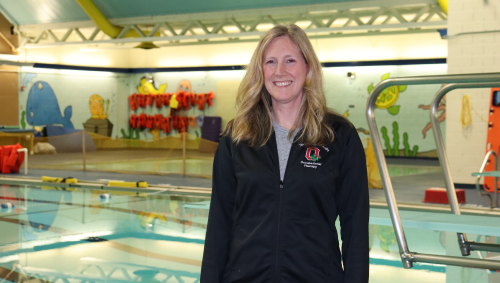Spotlight on Pediatric Aquatic Occupational Therapy

Erika Kemp, OTD, OTR/L, BCP, FAOTA, Associate Professor, Clinical, Interim Program Director, Division of Occupational Therapy, AquOTic Lab, The Ohio State University; Chair, AOTA Commission on Education
AOTA Member Erika Kemp, OTD, OTR/L, BCP, FAOTA, is a board certified pediatric occupational therapist with expertise in sensory integration, feeding, and aquatics. She has a bachelor's degree in occupational therapy from Ohio State University, a post-professional master's from Boston University, and post-professional doctorate (OTD) from Indiana University.
Dr. Kemp worked in school, community and medical pediatric settings before moving into academia. She has worked in both occupational therapy (OT) and occupational therapy assistant (OTA) academic programs as a fieldwork coordinator and capstone coordinator. Now, Dr. Kemp serves as the interim program director of the OTD program at The Ohio State University, where she leads the AquOTic Research Lab.
AOTA recently had a conversation with Dr. Kemp about AquOTic, an occupational therapy based aquatic program, which uses sensory, behavioral, and motor learning approaches to help improve water safety and basic swim skills for children with Autism Spectrum Disorder (ASD)
Tell us about aquatic occupational therapy for children
Drowning is a leading cause of death for children with ASD. Swim skills are crucial to being able to survive an immersion event. Many children with disabilities struggle to learn new motor and/or cognitive skills, and swimming, particularly safe swimming, requires both.
Aquatic occupational therapy provides myriad benefits for children with ASD and other disabilities. For those with physical challenges, water provides increased freedom of movement due to the unique properties of water, specifically buoyancy and flow. For all kids, providing therapy in an aquatic environment can introduce new activities, excite them to get out, and can simulate a desired family community outing, facilitating participation. Aquatic OT is a great way to extend the benefits of land-based therapy, or a way to switch things up when a plateau is reached on land.
What Kinds of Activities are Included in Aquatic OT?
There are a wide range of options, including:
- Group based swim instruction with 1:1 assistance to facilitate swim skills using individualized stations to help adjust skills to the level of each child <
- Self-care activities before and after the pool including dressing, undressing, showering, and toileting.
- Upper extremity and trunk strength is addressed through the use of climbing out/jumping into the pool as well as swim strokes and 'monkey crawl' along the edge of the wall. All of these activities not only increase strength but also provide an opportunity for some swim skill acquisition.
- Upper extremity coordination such as scoop/dump, clothespin games, squeeze toys, squirt guns, water transfer games.
- Safety awareness such as listening to pool staff and lifeguards, recognizing pool safety markings, learning to walk on deck, to jump where the water is clear, and how to interact in a public locker room.
Could You Provide a Real World Case Study?
I worked with an 11-year-old boy on the autism spectrum that had reached most land-based fine motor goals, but still had sensory processing challenges, low endurance, lower muscle tone. The family was looking for additional ways to spend time together, and the younger sister was on a swim team.
The boy enjoyed the pool and could swim a few feet with a doggie paddle, but would not put his head under water or swim in water over his head. We decided to try aquatic OT for an eight-week period to provide safety swim skills such as holding his breath, floating and moving through the water to increase his strength, endurance and safety in and around water. After the eight-week session the client was able to tolerate water on his face and was submerging to pick up items off the floor in three feet of water.
He had moved from a bicycle kick to a flutter kick and could blow bubbles while kicking. He expressed a desire to learn to swim and dive like his sister.
Therefore, we extended his therapy for an additional eight weeks, where we focused on trunk and upper body strength through floats and full body swimming and began sit/kneel dives. He was able to join a community swim team after one consultation with the coach to continue to refine his skills. He went on to swim year-round!
How do parents and caregivers access aquatic therapy for their children?
Many referrals can come from local aquatic centers to therapy providers in the area. Pediatricians can refer to OT for evaluation and treatment for aquatic therapy, just as they would for land therapy.
How can an occupational therapy practitioner (OTP) or student make their way into this as a specialty area?
First, get comfortable with water. This may be taking a swim instruction course through American Red Cross or the YMCA or perhaps a lifeguard training course to become familiar with the properties and dangers of water. Then, put on your OT hat and use activity analysis to think of ways to move activities from land to water, and to analyze the various swim skills to help adapt to multiple types of learners.
How does AOTA support your practice or your learning?
The new Aquatic OT Community of Practice is a great way to learn from and with other OTs,, OTAs, and students! The Aquatic OT Community of Practice connects members wishing to explore occupational therapy's role in water related activities including aquatic safety, swim skills, drowning prevention, self-care, motor skills, social participation, parent education, advocacy, lifelong recreation and leisure, and more. It is housed within the AOTA Children & Youth Special Interest Section.